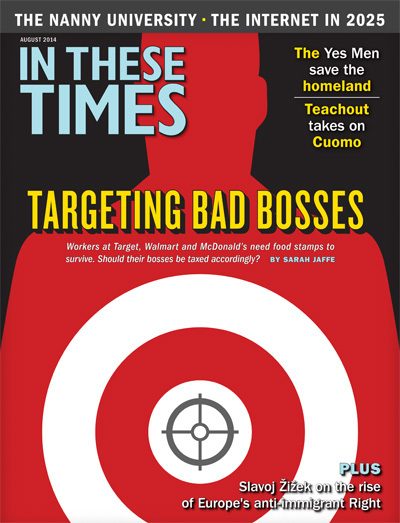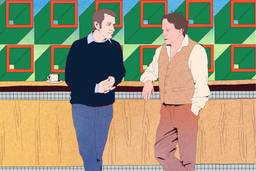The Uses of Enchantment
In Enchanted Objects, David Rose rhapsodizes about the coming Internet of Things. But can high-tech objects really reconnect us?
Jessica Stites

In case you haven’t seen the signs, there’s a radically new future blinking ahead: the ‘Internet of Things.’ By 2025, the tech gurus tell us, all manner of objects, from T-shirts to trash cans, will be outfitted with sensors and linked to the cloud, quietly looking after our needs and interests like a flock of fairy godmothers.
Tech entrepreneur and MIT professor David Rose offers a seductive portrait of this coming age in his new book, Enchanted Objects: Design, Human Desire, and the Internet of Things. In his youth, Rose was deeply impressed by the utility and elegance of Bilbo Baggins’ sword Sting in The Hobbit, which glowed blue in the presence of goblins. Sting inspires Rose’s vision of a “swarm” of “a thousand just-smart-enough things” that provide “emotionally engaging, useful and benevolent services.” That vision involves a lot of glowing: Rose rhapsodizes about an umbrella that glows when it’s raining so you won’t forget it, a picture frame that lights up when your friend squeezes a corresponding frame (to show she is thinking of you), lights that change color with the price of electricity, and his own invention, the GlowCap, a prescription bottle top that flashes when it’s time for the next pill. Aesthetically and pragmatically, it’s an attractive vision, if a little busy. In the near future, we will all be wizards, a cloud of floating orbs pulsating gently around us.
Rose comes off as a well-intentioned guy, concerned about the environment, generally interested in doing good, contagiously enthusiastic about problem-solving, more comfortable with objects than people. In other words, an engineer. He’s aware of the dystopian potential of any new technology: When he fantasizes about the Internet of Things logging our daily activities so as to nudge us toward better health choices, for instance, it’s with the caveat that employers and the government not have access to the data.
Nonetheless, he occasionally sounds like Dr. Evil. “Imagine the thrill of your children hitting the top rungs of Internet leaderboards for brushing their teeth!” he exults. He banishes the entire “downstairs” of Downton Abbey in one sweeping vision of “animated devices taking the place of Anna, James, Carson and Mrs. Hughes.” And there are his schemes to boost worker productivity: At the behest of Bloomberg L.P., his firm created “spinners” meant to motivate employees. Hung above Bloomberg’s 130-person sales pit, the spinners displayed the relative speed at which five teams conducted financial transactions. Lo and behold, the teams worked faster when monitored, an effect Rose attributes to the benign motivational power of competition — rather than, say, the fear of one’s boss.
Rose also envisions information workers of the future becoming more efficient by analyzing data simultaneously via all five senses. Georgia Tech professor Bruce Walker has already modeled this, with a program that feeds market data to stock analysts through “a wide range of sounds taken from nature” — the price of gold, for instance, might be represented in birdsong. While stock traders might not be the most sympathetic of guinea pigs, contemplating how such technologies could be applied to McDonald’s workers becomes rather alarming.
To be fair, while Rose willingly caters to businesses’ desire to squeeze ever more labor out of an exhausted workforce, his real passion is using enchanted objects to spur human connection. He rails against the proliferation of tablets and smartphones, which he believes distance us from others and divide our attention, creating a “colder, more isolated, less humane world.” Rose promises that a world of enchanted objects will hearken back to pre-tablet, even artisanal, times — serving, like his grandfather’s woodcarving tools, as “a pleasure to work with and to display.”
It’s a bit odd to imagine a more “humane” future that revolves around displaying objects to each other. By 2025, we shall all become circles of grade-schoolers showing off our Playstations. But some of Rose’s inventions go beyond I’ll-show-you-mine-and-you’ll- show-me-yours to facilitate real interactions. For the gaps in our bookshelves left by Kindle, he imagines a silvery screen to Skype with our grandparents or grandchildren (which, naturally, glows to signal they are near).
All this mediation may take a toll on immediacy and presence, not to mention sanitize the messy unpredictability of human interaction, but Rose sees that as a feature, not a bug. He takes technology theorist Sherry Turkle’s observation that “we are lonely, but fearful of intimacy” as a design principle rather than a paradox. He fantasizes about “an enchanted wall in your kitchen that could display, through lines of colored light, the trends and patterns in your loved ones’ moods.” (One wonders if he knows the phrase, “How are you?”)
All of this smacks of the basic, insidious mechanism at the heart of consumerist capitalism: It feeds on its own excesses, the snake eating its tail. It promises to fulfill our every need, but instead, multiplies our needs ad infinitum. Commodities create problems that must be solved with more commodities. Buy conditioner to replenish the moisture stripped by shampoo! Buy an “enchanted wall” that displays your daughter’s feelings, because her eyes are fixed on her computer! At one point, Rose suggests that we may help save the planet by buying a talking trash can to chide us for buying too much, like a socially conscious Oscar the Grouch.
But of course, our overconsumption — and our alienation from each other and from our own labor — did not begin with the smartphone, nor will it end with the mood wall. Nearly everything about consumer capitalism drives us apart. We are scattered by the tides of globalization, pushed into ever-longer work hours, then marketed ever-more-intricate products to comfort and entertain us in place of the caretaking and camaraderie that are the glue of human connection. As Jean Baudrillard wrote, “Strictly speaking, the humans of the age of affluence are surrounded not so much by other human beings, as they were in all previous ages, but by objects. Their daily dealings are now not so much with their fellow men, but rather — on a rising statistical curve — with the reception and manipulation of goods and messages.”
Even as it promises to restore connection, corporate capitalism inches closer and closer to realizing Marx’s foreboding vision of “a time when everything that people consider as inalienable will become an object of exchange, of traffic, and can be alienated. This is the time when the very things which till then had been communicated, but never exchanged, given, but never sold, acquired but never bought — virtue, love, conviction, knowledge, conscience — when everything, in short, passed into commerce.”
The Internet of Things may indeed correct the fragmentation of Tablet World. But when we have cocooned ourselves in glowing objects, will we find ourselves any less alone?
Jessica Stites is Editor-at-large for In These Times.









